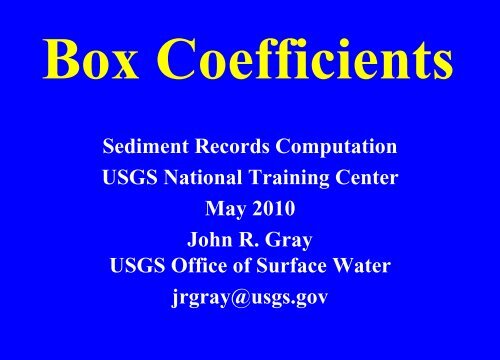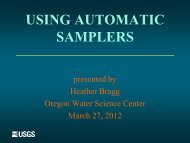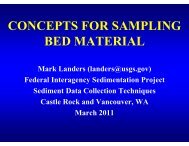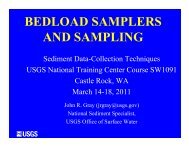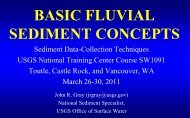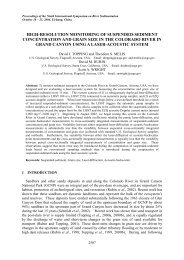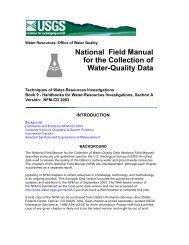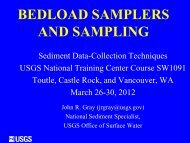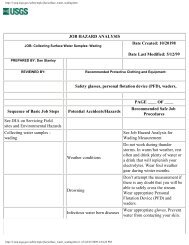J_src_jrg_box_coeff_..
J_src_jrg_box_coeff_..
J_src_jrg_box_coeff_..
You also want an ePaper? Increase the reach of your titles
YUMPU automatically turns print PDFs into web optimized ePapers that Google loves.
Box Coefficients<br />
Sediment Records Computation<br />
USGS National Training Center<br />
May 2010<br />
John R. Gray<br />
USGS Office of Surface Water<br />
<strong>jrg</strong>ray@usgs.gov
What is a “Box Coefficient?”<br />
It‟s USGS Jargon…<br />
• A mean flow-weighted x-sectional<br />
constituent concentration divided by a<br />
mean concentration at a point or vertical.<br />
Mean Concentration x-section mg/L<br />
-----------------------------------------<br />
Mean Concentration partial mg/L
Coefficient Derivation Example<br />
• Pumped sample conc:<br />
74, 67, 77, 79 mg/L<br />
– Mean value is 74.25 mg/L<br />
• X-section conc:<br />
90 and 98 mg/L<br />
– Mean value is 94.0 mg/L<br />
• Box Coefficient = 94.0/74.3 = 1.27<br />
• If this <strong>coeff</strong>icient proved to be constant over time and<br />
range of discharges – don’t count on it – one would<br />
multiply all concentrations from pumped samples by<br />
1.27 to obtain mean x-section sed conc.
Importance of the Box Coefficient<br />
• After data density -- missing record -- the<br />
derivation and application of the <strong>box</strong><br />
<strong>coeff</strong>icient is the most important variable<br />
in computation of daily sediment records.<br />
• The <strong>box</strong> <strong>coeff</strong>icient serves as a guide for<br />
locating, or relocating, the sampling<br />
vertical or sampler intake.
Some Factors in the Spatial<br />
Distribution of Sediment<br />
• Stokes Law (~size distribution of sediment)<br />
• Proximity to upstream tributaries<br />
• Bedforms, or lack thereof<br />
• Channel alignment and secondary motion<br />
• Bank stability<br />
• Local features (natural and human-made)<br />
• Source and type of sediment<br />
• Discharge<br />
• Season (indirect variable)<br />
• Location of sampling location/intake with respect<br />
to on-stream features and range-of-stage
Box Coefficient (BC) = C mean /C point<br />
C mean = ~930 mg/l<br />
BC=~1.1<br />
BC=~1.1<br />
BC=1.03<br />
BC=~1
Box Coefficient (BC) = C mean /C point<br />
C mean = ~1,360 mg/l<br />
BC=~4<br />
BC=~5<br />
BC=~1.7<br />
BC=~1.5
Incomplete mixing,<br />
downgradient from<br />
Bering Glacier,<br />
SE Alaska
Colorado<br />
River<br />
.<br />
Cisco<br />
Drains 1/8<br />
Of the<br />
Lower 48<br />
USA<br />
Land Area
Double-Mass<br />
Curve for<br />
Green River at<br />
Flaming Gorge<br />
Dam Completed<br />
November 1962<br />
Green River, Utah<br />
1930-82<br />
X-axis: cumulative annual<br />
water discharges<br />
Y-axis: cumulative annual<br />
suspended-sediment<br />
load<br />
~1945<br />
(from Thompson, 1984)
Double-Mass<br />
Curve for<br />
Blue Mesa Reservoir Dam<br />
Closed November 1965<br />
Colorado River<br />
at Cisco, Utah<br />
1930-82<br />
X-axis: cumulative<br />
annual water<br />
discharges<br />
Y-axis: cumulative<br />
annual suspendedsediment<br />
load<br />
(from Thompson, 1985)<br />
~1945
Double-Mass<br />
Curve for<br />
San Juan River<br />
Record Daily Sediment<br />
Load, October 20, 1972<br />
near Bluff,<br />
Utah<br />
1930-80<br />
X-axis: cumulative<br />
annual water<br />
discharges<br />
Y-axis: cumulative<br />
annual suspendedsediment<br />
load<br />
~1944<br />
(from Thompson, 1982)
Hypothesized Causative<br />
http://water.<br />
Factors: Changes in…<br />
• Land-Use?<br />
• Vegetation?<br />
• Climate?<br />
• Intrinsic Tributary Geomorphic<br />
Processes?<br />
• Or… (Topping et al, 1996)
The Colorado<br />
River Sampler<br />
Used until the<br />
mid-1940’s
The US-D43 Isokinetic Suspended-Sediment Sampler.<br />
Isokinetic samplers used by Fed. Gov’t since mid-1940’s
Site Selection, Not At Existing Gage<br />
(subtitled, “Before the damage is done?”)<br />
• Section or reach that has high<br />
potential for being “typical” for<br />
constituent to be measured over a<br />
broad range of flows (bedload vs<br />
suspended load).<br />
• MUST be in sync with project<br />
objectives and target data base.
Site Selection, Not At Existing Gage<br />
(subtitled, “Before the damage is done?”)<br />
• Some Desirable Characteristics:<br />
- No untractable safety issues over range<br />
of manual measurements (a must)<br />
- Stable stage-discharge relation<br />
- Accessible and measurable at all flows<br />
- Ability to measure all flows at same<br />
section<br />
- No artifacts attributable to local<br />
in-stream features
Site Selection, Not at Existing Gage<br />
(continued)<br />
• Measure at range of flows – particularly<br />
medium and high flows – minimum<br />
~8-section EDI measurements before<br />
installing fixed sampling equipment.<br />
• Install fixed sampling equipment based on<br />
information derived from above efforts.<br />
Goal is to obtain <strong>box</strong> <strong>coeff</strong>icients nearest to<br />
1.0 over range of flows, but particularly at<br />
medium-to-high flows (important concept!)
Utilizing an Existing Gage<br />
(subtitled, “After the damage is done?”)<br />
• If unrushed (yes, I do have a sense of humor), use<br />
methods described in previous slides for “new site.”<br />
• More typically, must install equipment and start<br />
monitoring immediately; in that case:<br />
- Use best judgment for installing fixed<br />
sampling features.<br />
- Consider using “Gray‟s „1/3‟ rule-of-thumb”<br />
(select vertical 1/3 from either side of stream –<br />
why? Middle & edges are ~atypical sections)<br />
- Use EDI method. Try to have one section<br />
coincide with the fixed sampling point.
Some Tips for Minimizing Problems<br />
• SOP: Scrutinize samples upon collection.<br />
- Is there a visual correlation between<br />
estimated concentrations in samples<br />
(adjusting for water volume)?<br />
- Do x-section to <strong>box</strong> sample estimated<br />
concentrations compare favorably?<br />
- Is there a reason to anticipate problems in<br />
the record-computation step? If “yes”<br />
remain at site/take additional samples…
Some Tips for Minimizing Problems<br />
(continued)<br />
• Take good notes intended for anyone‟s use<br />
(think 2 decades hence – will your notes<br />
be understandable and relevant?)<br />
• Have EDI samples analyzed separately;<br />
display on a cross-sectional plot. At least<br />
one full particle-size analysis/sand-fine split.<br />
• Use particle-size distributions to identify<br />
trends and problems.<br />
• Data collector should be record worker.
Box Coefficient Analysis Steps<br />
Primary Data Review<br />
• Job #1: Separate the Data from the Doodoo.<br />
- Are data consistent with other evidence?<br />
Good indicator if not necessarily “good”<br />
- If inconsistent, not necessarily bad.<br />
- Can you discredit data based on lab info,<br />
field notes, sedimentological theory,<br />
other information? If so, clearly<br />
document rationale, outcome.
Box Coefficient Analysis Steps<br />
(Primary Data Review, cont.)<br />
• Try to discredit data that plot oddly; if you are<br />
unsuccessful, ask yourself:<br />
- Do you know more than what the sample<br />
is “telling you”?<br />
- How influential is the sample (flow rate, etc)?<br />
- How often are you dealing with such<br />
problems, and how to minimize them?<br />
Relation between lab work and field work key.
Box Coefficient Analysis Steps<br />
(Primary Data Review, cont.)<br />
• Adulterated samples almost always result<br />
in larger concentration values.<br />
• Be reluctant to discard data points.<br />
• Be ***extremely*** reluctant to discard<br />
hydrographer x-sections. If results aren’t<br />
used, why bother to collect these data?<br />
• Document, document, document.
Box Coefficient Analysis Steps<br />
(Primary Data Review, Example.)<br />
• EDI cross-section sample values:<br />
55, 50, 66, 58, 596; mean = 165 mg/L<br />
• Observer <strong>box</strong> values:<br />
57, 65, 66, 64, 63; mean = 63 mg/L<br />
• Dude, what do I do?!?!<br />
(a) panic -- suffer your 19 th nervous breakdown<br />
(b) punt<br />
(c) call John…
Box Coefficient Analysis Steps<br />
(Primary Data Review, Example.)<br />
Outlier included:<br />
Conc mean = 165 mg/L<br />
Box Coefficient = 2.62<br />
Outlier excluded:<br />
Conc mean = 63 mg/L<br />
Box Coefficient = 1.10<br />
700<br />
700<br />
600<br />
Concentration, mg/L<br />
600<br />
500<br />
EDI X-Section from Left Bank<br />
500<br />
400<br />
400<br />
300<br />
300<br />
200<br />
200<br />
100<br />
100<br />
0<br />
1 2 3 4 5<br />
0<br />
1 2 3 4 5
Box Coefficient Analysis Steps<br />
Trend Analysis<br />
• Discharge Trends: Most common, have<br />
physical basis, hydrographer’s 1st choice.<br />
• Time Trends: Laborious to apply<br />
correctly; objective rarely achieved.<br />
• Concentration Trends: Sometimes<br />
informative, but no slick method to apply.<br />
• Phase of the Moon…?
Box Coefficient Analysis Steps<br />
Magnitude of Box Coefficients<br />
• No hard-and-fast, nor statistically based<br />
rules -- yet; site and data dependent.<br />
• Rule of thumb: 0.67 to 1.5 “tractable.”<br />
• Unusually small (~2)<br />
<strong>coeff</strong>icients are often cause for concern;<br />
influence of computational process<br />
becomes inordinately large –<br />
“manhandling the data”
Box Coefficient Analysis Steps<br />
Magnitude, Box Coefficients (cont.)<br />
• Where no trends are evident, data are<br />
more or less evenly distributed around a<br />
constant (ideally 1.0), may use constant.<br />
• Where trends are evident, varying<br />
<strong>coeff</strong>icients should always be applied.
Box Coefficient Analysis Steps<br />
Magnitude, Box Coefficients (cont.)<br />
• Streams carrying smaller sediment<br />
concentrations, and/or streams with<br />
comparatively large amounts of sand, tend to<br />
have widely varying <strong>coeff</strong>icients.<br />
• Hellacious or widely varying <strong>coeff</strong>icients are a<br />
signal to change something: The location of<br />
the fixed sampling equipment, QC practices,<br />
etc. Before changes, ask, “will it help?”
Box Coefficient Analysis Steps<br />
Magnitude, Box Coefficients (cont.)<br />
• Insufficient data and <strong>coeff</strong>icients of 1.0:<br />
- Should 1.0 <strong>coeff</strong>icient be the default?<br />
- Is there a physical basis for this?<br />
- Are 1.0 <strong>coeff</strong>icients just convenient?<br />
- Is a <strong>coeff</strong>icient of 1.0 equivalent to:<br />
1.0000? 0.99-1.01? 0.9-1.1? 1.25-0.8?
Box Coefficient Analysis Steps<br />
Application<br />
• GCLAS – a brave new world…<br />
- Capability to apply discharge, time, and<br />
discharge+time-weighted <strong>coeff</strong>icients.<br />
- Good news – better, faster data<br />
computations, easier verification.<br />
- Bad news…You now have No Excuses<br />
in credible application of <strong>coeff</strong>icients!
Box Coefficient Analysis Steps<br />
Advice<br />
• Don’t sweat low-flow <strong>coeff</strong>icients.<br />
- Low-concentration (
Box Coefficient Analysis Steps<br />
Advice (cont.)<br />
• Try to identify <strong>coeff</strong>icient-discharge<br />
relations and apply by methods analogous<br />
to stage-shift variation for discharge.<br />
• Sample at-a-point sequentially to develop<br />
a time series that sheds light on variance<br />
on in-stream processes<br />
• Automatic samplers need extra attention.
Box Coefficient Analysis Steps<br />
Advice (cont.)<br />
• Beware of comparing results from data<br />
collected in different sections (Des Plaines<br />
River at Riverside example).<br />
• Avoid data collection in eddies.<br />
• NO cross-sectional data collected???!!!<br />
- Obvious first question…why not?<br />
- Ask: What is data quality? Answer?<br />
- May need to consider another approach –<br />
surrogate technology?
Box Coefficient<br />
Yellow Creek near Middlesboro, KY,<br />
3.50<br />
3.00<br />
2.50<br />
2.00<br />
1.50<br />
1.00<br />
0.50<br />
0.00<br />
WY 1992<br />
6/11 9/19 12/28 4/6 7/15 10/23<br />
Date
Box Coefficient<br />
Yellow Creek near Middlesboro, KY,<br />
WY1992<br />
3.50<br />
3.00<br />
2.50<br />
2.00<br />
1.50<br />
1.00<br />
0.50<br />
0.00<br />
0 1000 2000 3000 4000 5000<br />
Discharge
Box Coefficient<br />
Yellow Creek near Middlesboro, KY,<br />
WY1992<br />
3.50<br />
3.00<br />
2.50<br />
2.00<br />
1.50<br />
1.00<br />
0.50<br />
0.00<br />
0 1 2 3 4<br />
Log10 Discharge, cfs
Box Coefficient<br />
Cumberland River at Williamsburg, KY<br />
2.00<br />
1.50<br />
1.00<br />
0.50<br />
0.00<br />
11-Jun-<br />
91<br />
19-Sep-<br />
91<br />
28-Dec-<br />
91<br />
06-Apr-<br />
92<br />
15-Jul-<br />
92<br />
23-Oct-<br />
92<br />
Date
Box Coefficient<br />
Cumberland River at Williamsburg, KY<br />
2.00<br />
1.50<br />
1/10/92<br />
1.00<br />
0.50<br />
0.00<br />
0 1000 2000 3000 4000<br />
Discharge, cfs
Box Coefficient<br />
2.00<br />
1.75<br />
1.50<br />
1.25<br />
1.00<br />
0.75<br />
0.50<br />
0.25<br />
0.00<br />
Cumberland River at Williamsburg, KY<br />
(additional data from other years)<br />
1/10/92<br />
0 10000 20000 30000 40000<br />
Discharge, cfs
Box Coefficient<br />
Green River at Mumfordville, KY<br />
12<br />
10 11<br />
9<br />
8<br />
7<br />
6<br />
5<br />
4<br />
3<br />
2<br />
0 1<br />
09/19/91 12/28/91 04/06/92 07/15/92 10/23/92<br />
Date
Box Coefficient<br />
Green River at Mumfordville, KY,<br />
WY1992<br />
10 11 9<br />
8<br />
7<br />
6<br />
5<br />
4<br />
3<br />
2<br />
0 1 0 2000 4000 6000<br />
Discharge, cfs
Box Coefficient<br />
Green River at Mumfordville, KY<br />
Coefficient = 10.77 Removed<br />
3.00<br />
2.50<br />
2.00<br />
1.50<br />
1.00<br />
0.50<br />
0.00<br />
0 2000 4000 6000<br />
Discharge, cfs
Box Coefficient<br />
Rio Puerco near Bernardo, NM<br />
2.50<br />
2.00<br />
1.50<br />
1.00<br />
0.50<br />
0.00<br />
7/24/98 11/1/98 2/9/99 5/20/99 8/28/99 12/6/99
Box Coefficient<br />
Rio Puerco near Bernardo, NM<br />
2.50<br />
2.00<br />
1.50<br />
1.00<br />
0.50<br />
0.00<br />
0 50 100 150 200 250 300 350<br />
Discharge, cfs
Box Coefficient<br />
San Joaquin River near Vernalis, CA<br />
1.400<br />
1.200<br />
1.000<br />
0.800<br />
0.600<br />
0.400<br />
0.200<br />
0.000<br />
7/24/98 11/1/98 2/9/99 5/20/99 8/28/99 12/6/99
Box Coefficient<br />
San Joaquin River near Vernalis, CA<br />
1.400<br />
1.200<br />
1.000<br />
0.800<br />
0.600<br />
0.400<br />
0.200<br />
0.000<br />
0 2000 4000 6000 8000 10000 12000 14000<br />
Discharge, cfs
Hellbranch Creek, Ohio, WY 97
Box<br />
Coefficient<br />
6<br />
5<br />
4<br />
3<br />
2<br />
1<br />
0<br />
Elwha River above Lake Mills,<br />
Port Angeles, WA (1 of 2)<br />
(approximate, from old graph sheets)<br />
9/8/95 12/17/95 3/26/96 7/4/96 10/12/96<br />
Date
Box Coefficient<br />
Elwha River above Lake Mills,<br />
Port Angeles, WA (2 of 2)<br />
6<br />
5<br />
4<br />
3<br />
2<br />
1<br />
0<br />
0 2000 4000 6000 8000<br />
Discharge, cfs
ISCO <strong>coeff</strong>icient ratio<br />
iisco <strong>coeff</strong> ratio<br />
0.400<br />
Alameda Creek below Welch Creek near Sunol,<br />
CA<br />
0.350<br />
0.300<br />
0.250<br />
0.200<br />
0.150<br />
Series1<br />
Linear (Series1)<br />
0.100<br />
0.050<br />
0.000<br />
9/25/2007 11/14/2007 1/3/2008 2/22/2008 4/12/2008 6/1/2008<br />
time<br />
Alameda Creek below Welch Creek near Sunol<br />
1.000<br />
0.900<br />
0.800<br />
0.700<br />
0.600<br />
0.500<br />
0.400<br />
`<br />
0.300<br />
0.200<br />
0.100<br />
0.000<br />
0.00 20.00 40.00 60.00 80.00 100.00 120.00 140.00<br />
Discharge, in cfs
Box Coefficient Ratio<br />
Box Coefficient Ratio<br />
2.00<br />
Sacramento River at Freeport, CA<br />
1.80<br />
1.60<br />
1.40<br />
1.20<br />
1.00<br />
<strong>box</strong>_vs_time<br />
0.80<br />
0.60<br />
0.40<br />
0.20<br />
0.00<br />
9/1/2002 1/14/2004 5/28/2005Time<br />
10/10/2006 2/22/2008 7/6/2009<br />
Sacramento River at Freeport, CA<br />
2.00<br />
1.80<br />
1.60<br />
1.40<br />
1.20<br />
1.00<br />
0.80<br />
0.60<br />
0.40<br />
0.20<br />
0.00<br />
0 10000 20000 30000 40000 50000 60000 70000 80000 90000 100000<br />
Discharge, in cfs


